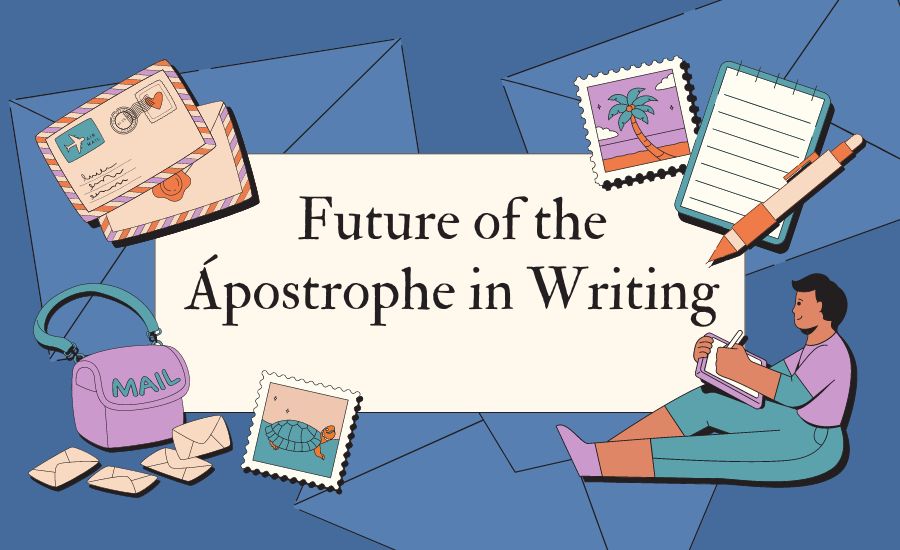Hey there, grammar fans! Have you ever wondered about that little squiggle in words like “it’s” and “don’t”? That’s the mighty ápostrophe! It may be small, but it helps us write clearly and correctly. In this blog, we’ll learn all about the ápostrophe and how to use it like a pro.
What is an Ápostrophe?
An ápostrophe is a small mark in writing that does a big job. It looks like a tiny comma that floats above the line. We use it to show that something belongs to someone or to shorten words. For example, “Sam’s book” uses an ápostrophe to show that the book belongs to Sam.
When we say “can’t,” the ápostrophe replaces the letters we left out in “cannot.” This makes it easier to read and write. The ápostrophe helps us understand whose stuff we’re talking about and makes sentences shorter and smoother.
You might see the ápostrophe in many places. It is used in signs, books, and even in text messages. Knowing how to use it right can make your writing clearer and more professional.
History of the Ápostrophe
The ápostrophe has a cool history! It first came from the Greek language and meant “to turn away.” In the 16th century, it started being used in French writing. Over time, it was adopted into English.
Back then, the ápostrophe was mainly used to show missing letters in words. Over the years, its use changed and expanded. Today, it helps with showing possession and forming contractions in English. The ápostrophe has become an important part of writing.
Its history shows how language evolves and adapts. What started as a simple mark became a crucial tool in our writing. Learning about its history helps us appreciate how important the ápostrophe is.
Why the Ápostrophe is Important

The ápostrophe might be a small mark, but it plays a big role in writing. This little punctuation helps us show ownership and create contractions, making our sentences clear and easy to read. Without it, our writing could become confusing, and we might mix up different meanings.
For example, take the difference between “Sarah’s book” and “Saras book.” The ápostrophe in “Sarah’s book” tells us the book belongs to Sarah. Without the ápostrophe, “Saras book” might be hard to understand and could even change the meaning. The ápostrophe makes sure everyone knows exactly what we mean.
Another important use of the ápostrophe is in contractions, like “don’t” for “do not.” These contractions help make our speech and writing sound more natural and less formal. Without the ápostrophe, contractions wouldn’t be as clear, and our writing might sound stilted or awkward.
How to Use an Ápostrophe for Possession
Using the ápostrophe to show possession is a key part of clear writing. When we want to indicate that something belongs to someone or something, we use the ápostrophe to make it clear. This small mark helps us avoid confusion about who owns what.
For singular nouns, we add an ápostrophe followed by an “s” to show possession. For example, “the cat’s toy” means the toy belongs to the cat. Here, the ápostrophe and “s” tell us that the toy is owned by just one cat. This rule is simple and helps keep sentences clear.
When we’re talking about plural nouns that end in “s,” we place the ápostrophe after the “s.” For instance, “the dogs’ park” shows that the park is used by multiple dogs. The ápostrophe after the “s” tells us that more than one dog uses the park. If the plural noun does not end in “s,” like “children’s books,” we add the ápostrophe and “s” to show possession.
Some names that end in “s” can be tricky. For example, we can write “James’s car” or “James’ car” to show the car belongs to James. Both forms are correct, but using “James’s” is more common in American English. Consistency in your writing is important, so choose one style and stick with it.
How to Use an Ápostrophe in Contractions
The ápostrophe plays a big role in contractions, making our writing and speech sound more natural and flowing. Contractions are shortened forms of words where some letters are left out and replaced with an ápostrophe. This tiny mark helps combine words smoothly and keeps our sentences easier to read and say.
For example, “do not” becomes “don’t” when we use a contraction. The ápostrophe takes the place of the missing “o” in “not.” Another common contraction is “you are,” which shortens to “you’re.” Here, the ápostrophe replaces the space and missing letters between “you” and “are.” These contractions help our sentences sound more casual and conversational.
It’s important to use contractions correctly to avoid confusion. For instance, “it’s” means “it is” or “it has,” while “its” shows possession (like “the cat chased its tail”). Mixing these up can lead to misunderstandings. In informal writing, such as emails or blog posts, contractions are fine and can make the text feel more friendly. However, in formal writing, like academic papers or business reports, you might want to avoid contractions to keep a professional tone.
Common Ápostrophe Mistakes to Avoid

Even experienced writers can make mistakes with the ápostrophe. A common error is using it to form plurals, like writing “apple’s” instead of “apples.” Plurals do not need an ápostrophe; just add “s” or “es.”
Another mistake is confusing “its” with “it’s.” “It’s” is a contraction for “it is” or “it has,” while “its” shows possession, like “the cat chased its tail.” Mixing these up can lead to confusing sentences.
Avoiding these mistakes helps make your writing clearer and more accurate. Always check your work for proper ápostrophe use to ensure your meaning is clear.
Ápostrophe Tips for Beginners
If you’re new to using the ápostrophe, here are some tips to get you started. First, remember to use it to show possession by adding an “s” after the ápostrophe for singular nouns, like “the teacher’s desk.”
Understanding Possessive Ápostrophes
Using ápostrophes to show possession is a fundamental skill. For a singular noun, add an ápostrophe and an “s” at the end. For example, “the dog’s bone” means the bone belongs to one dog. When dealing with plural nouns that end in “s,” place the ápostrophe after the “s.” So, “the cats’ toys” indicates that the toys belong to multiple cats. If the plural noun doesn’t end in “s,” like “children,” you should add “’s,” as in “the children’s playground,” to show possession.
Creating Contractions with Ápostrophes
Ápostrophes are also used to form contractions, which combine two words into one by replacing missing letters. For instance, “can’t” is a contraction for “cannot,” with the ápostrophe standing in for the “no.” Another example is “they’re,” which means “they are.” Using contractions can make your writing sound more natural and conversational, which is perfect for informal writing like blog posts or friendly emails.
Avoiding Common Mistakes
A common mistake with ápostrophes is confusing possessive forms with contractions. For example, “it’s” stands for “it is” or “it has,” while “its” is used to show possession, such as “the cat chased its tail.” Misusing these can change the meaning of your sentences, so it’s essential to get it right. Always proofread your writing to catch any errors and ensure clarity.
Proofreading for Ápostrophe Accuracy
To master ápostrophe usage, make proofreading a habit. Reading your work out loud can help you spot mistakes and ensure your sentences are clear. It’s also helpful to use grammar-check tools to catch any errors. With regular practice and careful checking, using ápostrophes correctly will become easier, making your writing more polished and professional.
Fun Facts About the Ápostrophe
The ápostrophe has some fun facts! Did you know it almost disappeared in the early 2000s? Some people wanted to remove it to simplify writing, but it stayed because it’s so useful.
Another fun fact is that the ápostrophe is used differently in various languages. In French, for example, it shows missing letters in words like “l’été” (the summer). These quirks make the ápostrophe an interesting part of language.
These facts show how special the ápostrophe is. It may be small, but it has a big impact on writing.
Ápostrophe Rules for Names Ending in “S”

Using the ápostrophe with names ending in “s” can be tricky. Some people write “James’s book,” adding an “s” after the ápostrophe, while others write “James’ book,” just adding the ápostrophe.
Both ways are generally acceptable, but consistency is important. Choose one style and stick with it to keep your writing clear and professional.
Following these rules ensures that names ending in “s” are handled correctly. This helps avoid confusion and keeps your writing looking polished.
The Ápostrophe in Plurals: When to Use It
Usually, we don’t use the ápostrophe to form plurals. For example, “cats” is the correct way to show more than one cat, not “cat’s.”
There are some exceptions, though. When pluralizing letters, numbers, or symbols, an ápostrophe can help avoid confusion, like in “mind your p’s and q’s.” This use helps keep things clear.
Knowing when and when not to use the ápostrophe in plurals helps you write accurately. Follow these rules to keep your writing clear and correct.
The Ápostrophe in Digital Communication
In texting and social media, people sometimes drop the ápostrophe to save time. For example, “dont” instead of “don’t.”
Even though digital communication is more relaxed, using the ápostrophe correctly can make your messages clearer and more professional. It shows you pay attention to details.
Keeping the ápostrophe in your writing, even online, helps make your communication effective and polished.
Read Next: Totallyndfw-Discover-Creative-Wonders
How the Ápostrophe Improves Readability
The ápostrophe helps make writing easier to read. It breaks up long words and shows where letters are missing, which makes sentences flow better.
Without the ápostrophe, sentences can get confusing. For example, “its raining” is harder to read than “it’s raining.” The ápostrophe helps avoid these kinds of mix-ups.
Using the ápostrophe correctly improves your writing’s readability. It helps readers understand your text more easily.
The Ápostrophe in Other Languages
The ápostrophe isn’t just for English. Many other languages use it, too. For example, in French, it shows missing letters in words like “l’hôtel” (the hotel).
Each language has its own rules for using the ápostrophe. Understanding these differences can help you appreciate its role in various languages.
Exploring how the ápostrophe is used around the world shows how versatile and important it is.
Teaching Kids About the Ápostrophe
Teaching kids about the ápostrophe can be fun! Use simple examples and games to help them understand its uses. For instance, show them how “Tom’s toy” means the toy belongs to Tom.
Interactive activities, like finding and correcting mistakes in sentences, can make learning engaging. Practice with plenty of examples to help them remember the rules.
Helping kids get a good grasp of the ápostrophe sets them up for clear writing in the future.
Ápostrophe Use in Branding and Marketing
In branding and marketing, the ápostrophe can make a big impact. A well-placed ápostrophe can make a brand name look more professional, like in “McDonald’s.”
Incorrect use of the ápostrophe can hurt a brand’s image. For example, “McDonalds” might look less polished. Proper use helps keep a brand’s name clear and memorable.
Attention to the ápostrophe in branding and marketing ensures your message is professional and effective.
Future of the Ápostrophe in Writing

Some people wonder if the ápostrophe will disappear with digital communication. Despite trends to drop it, the ápostrophe still plays an important role in writing.
The ápostrophe helps clarify meaning and avoid confusion. As long as clear communication is important, the ápostrophe will likely remain a key part of writing.
The future of the ápostrophe shows that even small punctuation marks have a big impact on how we write.
Conclusion
In summary, the ápostrophe is a small mark with a big job. It helps us show who owns something, like “Anna’s bike,” and makes words shorter and easier to read, like turning “cannot” into “can’t.” Without the ápostrophe, our writing could be confusing and hard to understand.
So, next time you write, remember how important the ápostrophe is. Using it correctly makes your writing clearer and more professional. It might be tiny, but the ápostrophe plays a huge role in making our sentences smooth and easy to follow.
FAQs
Q: What is the ápostrophe used for?
A: The ápostrophe helps show possession, like “Liam’s hat,” and makes contractions, like “don’t” from “do not.” It makes sentences clearer and easier to understand.
Q: Can I use the ápostrophe in all types of writing?
A: Yes, you can use the ápostrophe in most types of writing, including informal texts and professional documents. Just make sure to use it correctly to avoid mistakes.
Q: What are some common mistakes with the ápostrophe?
A: Common mistakes include using the ápostrophe for plurals, like “apple’s” instead of “apples,” and confusing “it’s” (it is) with “its” (possessive form). These errors can make your writing confusing.
Q: Do I need an ápostrophe for possessive pronouns?
A: No, possessive pronouns like “yours” and “hers” do not need an ápostrophe because they already show possession.
Q: How can I remember when to use the ápostrophe correctly?
A: Practice makes perfect! Read your sentences carefully and check if the ápostrophe is used to show possession or in contractions. Using grammar-check tools can also help.
Read Next: Hqpotner






